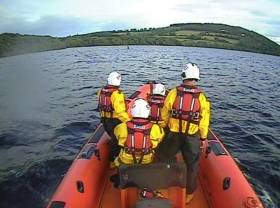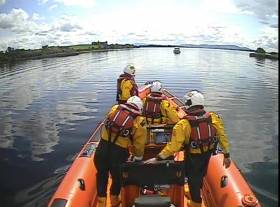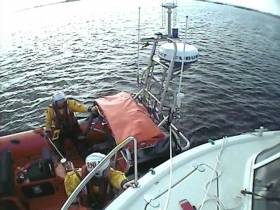Displaying items by tag: Lough Derg
Lough Derg Lifeboat Assists Boat After Engine Fire
On Tuesday evening (30 July), Lough Derg RNLI launched to the aid of an 18ft boat with engine failure by Mountshannon Harbour on the Clare shore.
On arrival at the reported location, the volunteer lifeboat was directed by Valentia Coast Guard to new co-ordinates as the vessel had drifted two miles south and was anchored at Castlelough on the Tipperary shore.
Once alongside, the crew observed that the boat’s onboard motor had had a fire.
The crew advised the skipper to disconnect the motor’s battery and the fuel line to the engine, and to locate the fire extinguisher.
Once satisfied the engine posed no danger, the lifeboat crew took the vessel under tow to Mountshannon where it was tied alongside at 8pm.
The crew then administered minor first aid to the skipper who had a recent finger injury and had lost the dressing from his wound.
Speaking following the callout, volunteer crew member Ger Egan said: “We would remind all boat users of the importance of doing regular checks on their boat’s engine and make sure it is serviced regularly.
“As we continue to enjoy the summer, we would also like to remind all users of the lake to respect the water.
“Always wear a lifejacket, always carry a means of communication and let someone on the shore know where you are going and when you are expected back.
“Should you get into difficulty, call 999 or 112 and ask for the coastguard.”
Lough Derg RNLI Assists 30ft-Cruiser Aground
Today Lough Derg RNLI was requested by Valentia Coast Guard to assist two people on a 30-ft cruiser who had become stuck on rocks on a raised shoal on the Eastern Shore of Lough Derg.
The lifeboat launched at 1.46 pm at the request of Valentia Coast Guard with volunteer crew members Dom Sharkey, Owen Cavanagh and Christian Parker and helmed by Eleanor Hooker.
Weather conditions were calm with force 2 winds and good visibility.
The lifeboat reached the casualty vessel and established that the people on board were safe and well. The lifeboat took soundings of depth on approach as the cruiser was high on a rocky shoal.
A crew member transferred to the vessel and checked it was not holed and the rudder and drives were all in good working order. With the crew member still aboard they set up a tow and took the boat off the rocks and into safe waters. The RNLI volunteer showed safe water and markers on the chart before the cruiser continued its journey without further assistance from the lifeboat.
Deputy Launching Authority, Brendan O’Brien said ‘We advise people using the lake to anticipate each marker on their route and study their charts when passage planning and to enjoy Lough Derg’
Vintage Barges Bring ‘Floating Fringe Festival’ To Mountshannon For June Bank Holiday Weekend
Vintage barges and fantastic events are promised in the line-up as the Mountshannon Arts Festival returns this June Bank Holiday, Thursday 30 May to Monday 3 June.
Inspired by this year’s theme, ‘Roots and Wings’, the festival features all facets of the arts including music, theatre, visual art, sculptures, films, poetry, literature, workshops, puppets, talks, walks, family fun and even a dog show.
And this year it will be almost two festivals in one as a gathering of vintage barges in Mountshannon Harbour on Lough Derg will comprise a floating fringe festival delivering a cargo of poetry, writing and performance.
Mountshannon Arts Festival has been running since 1995, and each year brings a new collection of exhibitions, performances and workshops to inspire and entertain both locals, and visitors to the area.
Rooted in the visual arts, the ethos of the festival is to create access to works and exhibitions that would not be easy to find in a rural area, while at the same time stimulating the creation of works and performances from within the local community.
For more information, visit www.mountshannonarts.net or find the festival on Facebook, Instagram and Twitter.
At 2.30pm, Saturday, May 11 2019, Lough Derg RNLI held their naming ceremony for their new inshore lifeboat, the Atlantic 85 B911 ‘Jean Spier’, in Dromineer.
The new B class lifeboat was donated to the RNLI by Robert Spier and his late wife Jean Spier. As active supporters of the RNLI they had together decided to donate money to the RNLI for an Atlantic lifeboat. Sadly Jean died in October 2017 and Robert dedicated the new boat in her honour.
With fantastic weather, the ceremony was held outside on the lawn of the Lough Derg Yacht Club. Children of the volunteer crew handed out brochures to guests as they arrived.
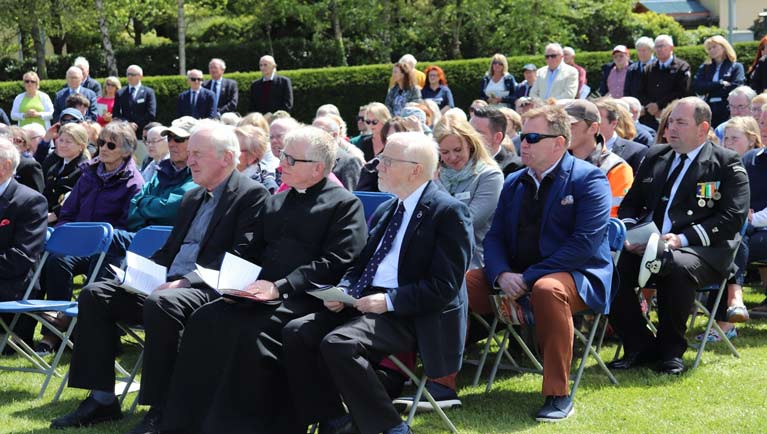 Guests on the lawn for the RNLI Lough Derg launch of the new lifeboat Photo: Geraldine Wisdom
Guests on the lawn for the RNLI Lough Derg launch of the new lifeboat Photo: Geraldine Wisdom
Niamh McCutcheon, Lifeboat Fundraising Chair and Irish Council Member opened the ceremony with special thanks to Robert Spier and the late Jean Spier for their generous donation.
Robert Spier expressed his pleasure in handing over the boat to the RNLI and into the care of Paddy McLaughlin, an RNLI Irish Council Member and Coxwain of Red Bay Lifeboat Station. Mr. McLaughlin thanked Robert, saying ‘there is no greater gift that we can receive, no act of generosity more appreciated by the volunteers than the bequest of a lifesaving vessel’.
Lough Derg Lifeboat Operations Manager, Liam Maloney accepted the lifeboat on behalf of volunteer crew, expressing his thanks to Robert and his late wife Jean, saying ‘on behalf of all of us at Lough Derg how proud we are to get this state of the art lifeboat for our station’. He acknowledged the magnitude of the gift, saying ‘This B class lifeboat means we now have the latest and finest rescue equipment available’.
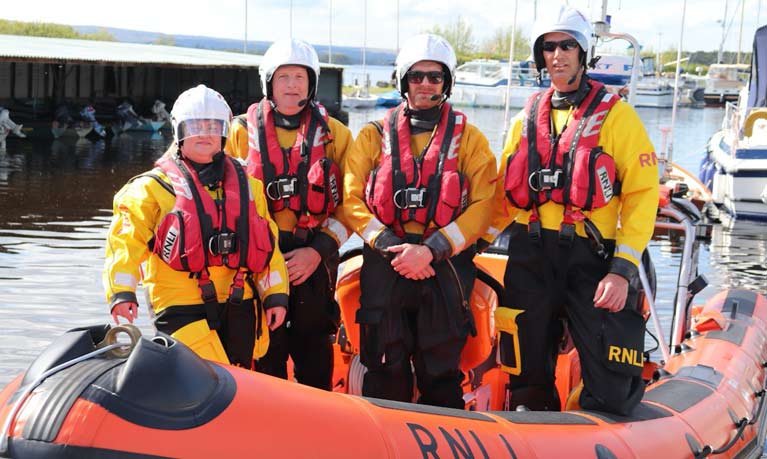 Volunteer crew – Doireann Kennedy, Dom Sharkey, Kjell Jimmy Gundergjerde and Joe O’Donoghue Photo: Geraldine Wisdom
Volunteer crew – Doireann Kennedy, Dom Sharkey, Kjell Jimmy Gundergjerde and Joe O’Donoghue Photo: Geraldine Wisdom
On behalf of all station personnel at Lough Derg RNLI, volunteer members Aoife Kennedy, Administrative Officer and Ger Egan, Lifeboat Mechanic and helm presented Robert with the signature Lough Derg jacket with the ‘Jean Spier’ crest as a token of their appreciation, and welcomed him as an honourary member of the Lough Derg Lifeboat team.
The Reverend Roderick Smyth and Father William McCormack were invited to lead a service of dedication before poet and Lough Derg volunteer helm Eleanor Hooker read her poem, Lifeboat: for Robert Spier, i.m. Jean Spier.
Robert then officially named the lifeboat ‘Jean Spier’ in Dromineer before Pat Kelly, Boathouse Manager closed the ceremony with a note of thanks to all involved in making the event so successful.
Following the ceremony, guests were invited for afternoon tea in the Yacht Club, provided by Simply Foods from Nenagh. Fundraising Committee member, and former Deputy Launching Authority Teddy Knight took guests out on the lake in his boat the Ku-Ee-Tu to watch a demonstration of the new lifeboat in action.
We would like to express our thanks to the Commodore Tadgh Murphy and his committee for permitting is the use of Lough Derg Yacht Club’s premises for the occasion, to Gerardine Wisdom, official photographer for the day, and for the support of our friends and colleagues in the RNLI and various rescue agencies who attended and to members of our local community who are unfailing in their support of the lifeboat.
The success of the day was in no small way due to the hard work by the dedicated team of volunteers at Lough Derg RNLI Station and fundraising and by Alex Sivyer and Emily Weaver from the Events and Ceremonies team who travelled over from RNLI Headquarters in Poole. This great team spirit contributed to the great atmosphere of celebration on the day.
Lough Derg Historian Questions Montague Dawson Painting Of Corinthian Race Sold At Auction
A painting by Montague Dawson recently sold at auction may not depict an amateur sailing race on Lough Derg as claimed, according to one yachting historian.
As previously reported on Afloat.ie, the painting titled ‘Racing for the Corinthian Challenge Cup on Lough Derg’, by the renowned maritime artist, fetched more than €87,000 in the Marine Sale at Bonhams in London last Wednesday (1 May).
The auctioneers confess that “it has not yet been possible to identify the specific race and those yachts depicted”.
But that could be because the race never happened, an expert on Lough Derg has suggested.
In correspondence seen by Afloat.ie, Vincent Delany — a member of the Association of Yachting Historians, author of a definitive history of Lough Derg’s yacht clubs, and a regular contributor to Afloat.ie — identified a number of reasons why he believes the painting takes artistic licence with its title.
Among them are the sail numbers, when Lough Derg boats used house flags; the size of the boats depicted, when there were no six-metre yachts on the lough; and the background, which is “not reflective of the hills of Co Tipperary, or of Cos Clare or Galway or the eastern shorelines of Lough Derg”.
Delany also posits that the quality of the lighting in the painting is more suggestive of the south of England than the lakes of the Shannon.
Afloat.ie awaits Bonhams’ response to Delany’s questions.
A 21ft motor boat with two people on board was rescued by Lough Derg RNLI after it ran aground in the lough on Sunday afternoon (5 May).
The volunteer crew with helm Eleanor Hooker, Joe O’Donoghue, Doireann Kennedy and Kjell Jimmy Gundergjerde launched their inshore lifeboat at 4.45pm in Force 2 north-north-west winds with good visibility to the location north of the mouth of the Scarriff River, where the 21ft boat was reported to be high on a shoal.
A crew member transferred to the motor boat and found that the people on board were unharmed and wearing their lifejackets.
The motor boat was checked for damage before a tow was set up and the vessel was removed from the rocks into safe water.
Once towed past the middle ground and the drives, steering and rudder were found to be in good working order, the boat was allowed to continue on its journey.
Helm Eleanor Hooker advises boat users “to plan your passage and pay close attention to the navigational marks at the entrance to harbours and rivers on the lake”.
The lifeboat returned to the station and was ready for service again at 7.15pm.
A painting by a renowned maritime artist of yachts racing on Lough Derg has fetched more than €87,000 at auction.
Afloat.ie reader James Gilna tipped us to the sale of ‘Racing for the Corinthian Challenge Cup on Lough Derg’ by Montague Dawson, which was auctioned last Wednesday 1 May at Bonhams in Knightsbridge, London.
There is some mystery surrounding the painting, which had been in a private collection since its original sale in 1984, as according to Bonhams “it has not yet been possible to identify the specific race and those yachts depicted”.
But regardless, the “spirited” work will surely bring much enjoyment to its new owner as one of the more lively examples of the famed maritime painter, whose patrons included the British royal family and two US presidents among many others.
#Rescue - Lough Derg RNLI and Killaloe Coast Guard launched to separate incidents on Easter Monday (22 April) that between them saw four people and a dog rescued on the lough.
In the first incident, Lough Derg’s inshore lifeboat launched to a 37ft cruiser aground north of the mouth of the Scariff River.
With southerly Force 2/3 winds and good visibility, the lifeboat arrived at the scene 45 minutes after its 4pm launch.
Winds had pushed the cruiser close to shore and raised it high out of the water, so the lifeboat approached with caution while the volunteer crew assessed the depths.
One the casualty boat’s sole occupant and skipper was confirmed safe and unharmed, and the boat was checked for damage and lightened for tow, the cruiser was taken off the rocks into deeper water and shortly after was allowed to continue its passage unaided.
At the same time, Killaloe Coast Guard was tasked to assist three people and their dog whose cruiser lost engine power and was blown onto the Clare shore of the lough.
The Killaloe Coast Guard rescue boat launched shortly after the 3.30pm alert and was alongside the casualty vessel within seven minutes.
Once all on board were confirmed safe and well, their boat was safely towed back to Killaloe.
It was the second callout of the Bank Holiday weekend for the Killaloe coastguard unit after a search for a missing person on Friday night (19 April) that concluded on a positive note as the individual was found safe on Saturday (20 April).
A few days previously, Lough Derg RNLI launched to a 60ft cruiser with seven on board that had run aground in Coose Bay.
Lough Derg RNLI Launch to 60-ft Vessel Aground in Coose Bay
At 3:40pm Thursday 18th April, Lough Derg RNLI was requested by Valentia Coast Guard to assist 7 people on a 60-ft cruiser aground in Coose Bay, between Split Rock and Hagen Rock.
Volunteer crew, with helm Eleanor Hooker, Owen Cavanagh, Keith Brennan and Doireann Kennedy arrived on scene and assessed the situation. Two experienced marine engineers Fergal Kearney and Will Ellis were also at the scene.
Visibility was good, with easterly winds, force 2/3.
The lifeboat took soundings of depth as it approached the casualty vessel which was aground on an extremely hazardous shoal. All passengers were wearing their lifejackets and were found to be well and unharmed. Two RNLI volunteers and Mr Kearney transferred to the cruiser and checked for ingress of water, found none but established that there was significant damage to the rudder.
Lifeboat crew set up for tow and eased the cruiser off the rocks and into safe water. The tow was passed to the rescue vessel from the cruiser company. An RNLI crew member remained with the casualty vessel until they were satisfied that the handover was complete.
The lifeboat returned to the Station and was ready for service at 6 pm.
Volunteer helm, Eleanor Hooker advises boat users ‘to remain with the navigation marks, and to ask locals about hazards before setting out from harbour’.
Lough Derg RNLI was requested by Valentia Coast Guard to assist four people, three adults and a child on a 35ft cruiser aground behind the Corrakeen Islands in Dromineer Bay yesterday.
The lifeboat was launched at 5.39pm with helm Eleanor Hooker, Dom Sharkey, Owen Cavanagh and Joe O’Sullivan on board. Winds were easterly, force 2 and visibility was good.
The crew arrived on scene within three minutes. The crew took soundings of depths as they approached the casualty vessel. An RNLI volunteer transferred to the cruiser and established that all passengers were safe and unharmed. He requested them to put on their lifejackets.
Once the lifeboat volunteer was satisfied that the cruiser was not holed, he set up for the tow. The lifeboat then took the cruiser off the rocks and into safe water, where its drives and steering were checked, and found to be undamaged.
With two volunteers on the cruiser with her passengers, the lifeboat accompanied them to Dromineer Harbour where the vessel was safely tied up alongside at 6.20pm.
The lifeboat returned to the station as was ready for service at 7 pm.
Volunteer helm Eleanor Hooker advises boat users to ‘remain within the navigation marks, and to ask locals about hazards before setting out from harbour’.


























